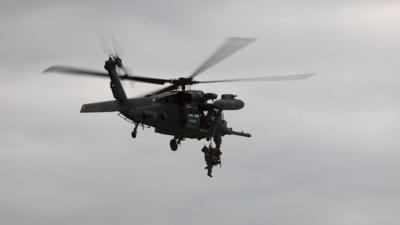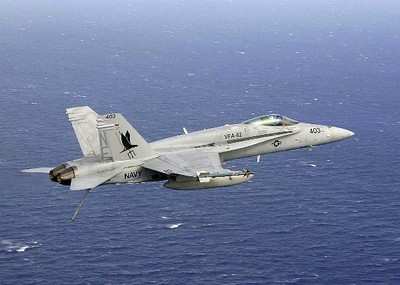Simulated Realistic Conditions After An Emergency Ejection From An F/A-18 Aircraft
U.S. Marines and Japan Self-Defense Force personnel conducted a bilateral search and rescue exercise at the Japan Ground Self-Defense Force Hijyudai Training Area, 27 April. The participating units included: Marine Fighter Attack Squadron 232, Marine Aircraft Group 12 and Ashiya Air Rescue Squadron, Air Rescue Wing.

The bilateral exercise allowed U.S. and Japanese forces to quickly and effectively carry out search and rescue operations, as well as refine communications between various organizations.
The event started with two pilots placed at separate locations in Hijyudai Training area to simulate realistic conditions after an emergency ejection from an F/A-18 aircraft. The simulated downed pilots then used their issued survival radios to communicate with each other and a wingman aircraft flying overhead.
“I loved being able to talk to one of my fellow squadron pilots as they were overhead looking for me,” said Captain Daniel Tolbert, one of the simulated downed pilots during the exercise. “I couldn’t stop thinking about how much more difficult this would be if I had really ejected and sustained injuries. I can imagine how uplifting it would feel to hear one of your own squadron’s jets overhead and hear your friends’ voices on the radio.”
After following a set of standard reporting procedures, all the necessary information was given to the Ashiya Air Rescue Squadron to arrange for recovery of the simulated downed pilots and follow-on transportation back to MCAS Iwakuni in a Japanese UH-60 helicopter.
Captain Nicholas Rowell, the other simulated downed pilot, commented on his experience with the Japanese Air Rescue Squadron saying “I thought communications with the aircrew would be difficult, given the language barrier, but they made the process easy to understand and were able to quickly extract us from the training area.”
On board the Japanese UH-60 helicopter, the pararescuemen performed medical checks on the pilots and began transporting them back to MCAS Iwakuni for follow-on treatment, which would signal the end of the exercise.

En route to MCAS Iwakuni, the Marines and Japanese pararescuemen shared in conversation and exchanged uniform patches as a sign of good will.
“The Japanese PJs were absolutely amazing,” said Tolbert, using an acronym for ‘pararescuemen’. “We were so impressed by their professionalism and how seriously dedicated they are.”
While speaking with one of the pararescuemen who had decades of experience in search and rescue operations, Tolbert mentioned that “there was an emotional moment for us when the PJs told us they are very sad whenever a pilot goes down and to be careful. I have lost friends in jet mishaps so it really hit me hard.”
When asked about their overall experience, both pilots commented on the boost in confidence they gained in their equipment and training as well as the reinforced trust they have in Japanese forces’ search and rescue capabilities.
“I have a lot of trust in my peers and the Japanese if we had to do this for real,” said Tolbert. “It made me realize that almost every day I trust my life to my friends and international partners.”
 Bolen Gives Congress a Rare Thumbs-Up
Bolen Gives Congress a Rare Thumbs-Up The SportPlane Resource Guide RETURNS!!!!
The SportPlane Resource Guide RETURNS!!!! Buying Sprees Continue: Textron eAviation Takes On Amazilia Aerospace
Buying Sprees Continue: Textron eAviation Takes On Amazilia Aerospace Hawker 4000 Bizjets Gain Nav System, Data Link STC
Hawker 4000 Bizjets Gain Nav System, Data Link STC Echodyne Gets BVLOS Waiver for AiRanger Aircraft
Echodyne Gets BVLOS Waiver for AiRanger Aircraft




